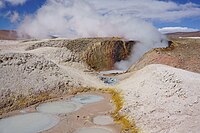
Photo from wikipedia
Abstract For the first time we present the geochemical characterization of fluids emitted from the Arjuno-Welirang volcanic complex and compare the results with those obtained sampling the neighboring spectacular Lusi… Click to show full abstract
Abstract For the first time we present the geochemical characterization of fluids emitted from the Arjuno-Welirang volcanic complex and compare the results with those obtained sampling the neighboring spectacular Lusi eruption site (Java Island, Indonesia). The isotopic composition of the hydrothermal and cold waters from the Welirang volcanic complex indicate a meteoric origin for these springs, with values ranging from −65 to −50 and −6 to −1‰ vs V-SMOW respectively for δD and δ 18 O. The water erupted from the Lusi site showed clustered higher δD and δ 18 O isotopic values, ranging around −6 and +10 vs V-SMOW respectively. We ascribe these results to mixing between hydrothermal fluids, meteoric water, saline formation fluids, and water released during clay mineral illitization ultimately altered by additional evaporation processes. The chemical and isotopic composition of fluids emitted from fumaroles and hydrothermal springs of the Welirang volcano showed a clear magmatic signature where a CO 2 -dominated gas reveals δ 13 C CO2 ranging between −5.9 and −2.4 and helium isotope with R/Ra = 7.3. These values are very close to those measured at Lusi site (R/Ra = 7) that also have high CO 2 /CH 4 ratio (1.7–2.2) supporting the high contribution of magmatic gases. Moreover, a great contribution of andesitic water has been recognized in the water vapour emitted from the summit fumaroles. Converging geochemical data indicate that the plumbing system of the Lusi eruption site is connected at depth with the Arjuno-Welirang volcanic complex. These data support a scenario where hydrothermal fluids from the volcanic system migrated in the sedimentary basin triggering metamorphic reactions in the organic-rich sediments that ultimately resulted in a venting system at the surface. After eleven years of incessant activity this venting system remains constantly fed by the fluids from the volcanic complex and became world known as “Lusi”, the largest ongoing clastic geysering system on Earth.
Journal Title: Marine and Petroleum Geology
Year Published: 2017
Link to full text (if available)
Share on Social Media: Sign Up to like & get
recommendations!